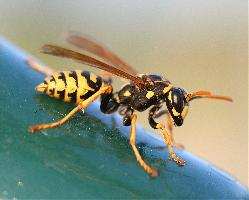
Weights and measures
| Length | from 18 to 30 mm |
|---|
State of endangerment
| Non Endangered |
Animal description
The Oriental hornet, scientifically named Vespa orientalis, is a captivating species of hornet that is indigenous to parts of the Middle East, North Africa, and extending into the Mediterranean regions of Southern Europe and parts of Asia. This striking insect is a member of the Vespidae family, which encompasses various species of wasps and hornets known for their social structure and complex behaviors.Physically, the Oriental hornet is a robust and visually striking creature. Adults typically measure between 25 to 35 millimeters in length, showcasing a distinctive coloration pattern that sets them apart from other hornet species. Their bodies are primarily characterized by a rich, reddish-brown hue on the thorax, with the abdomen featuring alternating bands of yellow and brown. The head is adorned with large, compound eyes that are dark in color, and they possess strong mandibles for feeding and nest construction. One of the most remarkable aspects of their appearance is the yellow stripe found on the fourth abdominal segment, which is thought to play a role in their unique ability to harvest solar energy.
The Oriental hornet is a diurnal species, exhibiting most of its activity during daylight hours. This behavior is quite unusual among hornets and is facilitated by their ability to utilize solar radiation. Researchers have discovered that the yellow stripe on the hornet's abdomen contains a pigment called xanthopterin, which is capable of converting solar energy into electrical energy. This adaptation is believed to assist the hornet in sustaining its high levels of activity throughout the day, especially in the hot climates that it inhabits.
Socially, the Oriental hornet lives in colonies that can range from a few dozen to several hundred individuals. These colonies are structured hierarchically, with a single fertile queen at the top, followed by workers and males. The queen is responsible for laying eggs, while the workers, which are all female, perform various tasks such as foraging for food, caring for the larvae, and maintaining the nest. The nests themselves are marvels of insect architecture, typically built underground or in sheltered locations. They are constructed from a mixture of saliva and chewed plant material, resulting in a paper-like substance that forms the chambers and tunnels of the nest.
The diet of the Oriental hornet primarily consists of insects, including flies, caterpillars, and other small invertebrates. However, they are also known to feed on fruits and sap, showcasing a degree of dietary flexibility. This hornet is also notorious for its aggressive behavior when defending its nest or when food is scarce, capable of inflicting a painful sting that can be dangerous to humans, particularly those allergic to wasp or bee stings.
In conclusion, the Oriental hornet is a fascinating species, notable for its unique physical characteristics, solar energy harvesting capabilities, and complex social structure. Despite its beauty and ecological significance, it is often regarded with caution due to its aggressive nature and potential to harm humans. As with many insects, the Oriental hornet plays a vital role in its ecosystem, contributing to the control of pest populations and the pollination of plants.
Similar Animals
New photos of animals
Top 10 animals
- Dolphin gull (Leucophaeus scoresbii)
- Diana monkey (Cercopithecus diana)
- Moustached guenon (Cercopithecus cephus)
- Galápagos tortoise (Geochelone nigra complex)
- Stone loach (Barbatula barbatula)
- Japanese macaque (Macaca fuscata)
- Greek tortoise (Testudo graeca)
- Russian tortoise (Testudo horsfieldii)
- Common flying dragon (Draco volans)
- Galápagos penguin (Spheniscus mendiculus)


